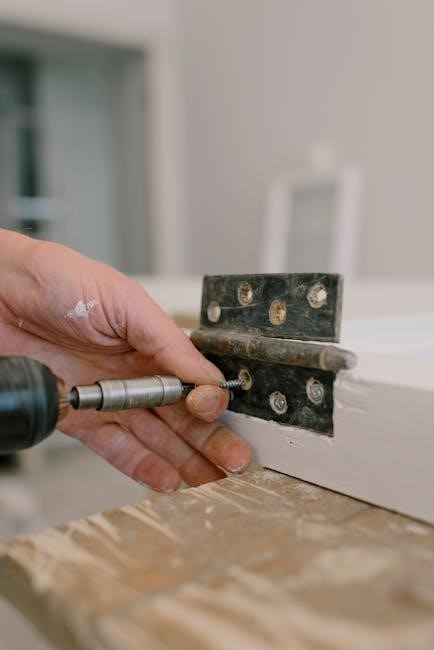Sears Craftsman garage door openers were a popular choice for homeowners seeking reliable and convenient operation. These openers, known for their robust construction and user-friendly features, often came with detailed manuals. These manuals are essential for safe installation, operation, and maintenance, ensuring longevity and proper function of the device.
Here’s the text for the “Understanding Your Sears Craftsman Garage Door Opener Model Number” section:

Understanding Your Sears Craftsman Garage Door Opener Model Number
The model number of your Sears Craftsman garage door opener is crucial for accessing the correct manual and replacement parts. This alphanumeric code, typically found on the opener unit itself, provides specific details about your device’s features, manufacturing date, and compatible accessories.
Locating the model number is the first step in troubleshooting any issues or performing maintenance. Common locations include the motor housing, usually on a sticker or plate. Once you’ve found it, record the number accurately.
The model number is your key to unlocking a wealth of information. Online databases, like Sears Parts Direct, use this number to provide you with the correct owner’s manual, parts diagrams, and troubleshooting guides specific to your opener. Without the correct model number, you risk using incorrect information, leading to improper repairs or incompatible parts.
Different model numbers signify different features, horsepower, and compatibility with accessories like remote controls and keypads. Some models might have safety features that others lack, making it critical to consult the correct manual for safe operation.
By understanding your Sears Craftsman garage door opener’s model number, you’re empowering yourself to properly maintain, repair, and extend the life of your garage door opener. This ensures safe and efficient operation for years to come.
Here’s the text for the “Locating and Downloading the Correct Manual” section:
Locating and Downloading the Correct Manual
Finding the right manual for your Sears Craftsman garage door opener is essential for safe operation and effective troubleshooting. With the model number in hand, you can begin your search online. Sears Parts Direct is a primary resource, offering a vast library of manuals for various Craftsman models. Simply enter your model number into their search bar to locate the corresponding manual.
If Sears Parts Direct doesn’t have your specific manual, try searching the general internet using your model number and the keywords “owner’s manual” or “user guide.” Numerous websites host appliance manuals, and one may have a copy of yours. Be cautious of unofficial websites, ensuring they are reputable before downloading any files.
Once you find a potential manual, verify that it matches your opener’s model number and features. Scrutinize the cover and introductory pages for accurate information. Download the manual as a PDF file for easy access on your computer, tablet, or smartphone.
After downloading, consider printing a hard copy for convenient reference in your garage. Keep the manual in a safe and accessible location near the opener. This will allow for quick consultation during maintenance, repairs, or when addressing any operational issues. A readily available manual is an invaluable tool for any Sears Craftsman garage door opener owner.
Here’s the text for the “Safety Precautions in the Sears Craftsman Garage Door Opener Manual” section:
Safety Precautions in the Sears Craftsman Garage Door Opener Manual
The Sears Craftsman garage door opener manual dedicates a significant portion to safety precautions, emphasizing the importance of preventing accidents and injuries. These precautions are not mere suggestions; they are critical guidelines that must be followed during installation, operation, and maintenance.
One of the most prominent warnings addresses the dangers of moving parts. The manual stresses the need to keep hands and other body parts clear of the garage door’s path while it’s in motion. Children should be supervised and kept away from the opener and the door itself.
Another crucial safety measure involves the proper functioning of the safety sensors. These sensors are designed to prevent the door from closing if an obstruction is detected. The manual provides detailed instructions on how to test these sensors regularly to ensure they are working correctly. If the sensors are not functioning, the opener should not be used until they are repaired or replaced.
The manual also warns against disabling any safety features or modifying the opener in any way that could compromise its safety. Ropes should be removed from the door to prevent entanglement. Finally, it emphasizes the importance of regular inspections and maintenance to identify and address any potential safety hazards.
Here’s the text for the “Installation Instructions from the Manual” section:

Installation Instructions from the Manual
The installation instructions within a Sears Craftsman garage door opener manual are paramount for ensuring the safe and effective operation of the unit. These instructions are meticulously detailed, guiding the user through each stage of the installation process, from initial preparation to final adjustments.
The manual typically begins by outlining the necessary tools and hardware required for the installation. It emphasizes the importance of having all the right equipment on hand before starting to avoid delays and potential safety hazards. A clear diagram often accompanies this section, visually representing each component and its corresponding part number.
The instructions then proceed step-by-step, covering the mounting of the opener unit, the attachment of the rail assembly, and the connection of the door arm. Precise measurements and alignment guidelines are provided to ensure the door operates smoothly and without binding. The importance of securely fastening all components is repeatedly stressed.
Electrical wiring is another critical aspect covered in the manual. It provides detailed instructions on how to connect the opener to a power source, adhering to all relevant electrical codes and safety regulations. The proper grounding of the unit is emphasized to prevent electrical shock.
Finally, the manual addresses the adjustment of the opener’s travel limits and force settings. These adjustments are crucial for ensuring the door opens and closes fully without causing damage to the door or the opener itself;
Here’s the text for the “Assembly Instructions from the Manual” section:

Assembly Instructions from the Manual
The assembly instructions detailed within the Sears Craftsman garage door opener manual are vital for the correct setup of the unit. These instructions provide a step-by-step guide, ensuring that even those with limited mechanical experience can successfully assemble the opener.
The manual typically starts with a comprehensive parts list, clearly identifying each component of the opener, from the motor unit to the rail sections and hardware. Diagrams accompany the list, offering a visual representation of each part and its corresponding name or number.
The assembly process generally begins with the rail assembly, which involves connecting multiple rail sections to create the track along which the garage door will travel. The manual provides precise instructions on how to align and secure these sections, ensuring a smooth and seamless track.
Next, the manual details the attachment of the trolley to the rail. The trolley is the component that connects the garage door to the opener and moves along the rail to open and close the door. Proper installation of the trolley is essential for reliable operation.
The motor unit is then attached to the rail assembly, usually at the header bracket above the garage door opening. The manual provides guidance on how to securely mount the motor unit, ensuring it is level and stable.
Finally, the manual covers the connection of the various cables, chains, or belts that transmit power from the motor to the trolley. It emphasizes the importance of proper tension and alignment for optimal performance.
Here’s the text for the “Operating Instructions” section:
Operating Instructions
The operating instructions in the Sears Craftsman garage door opener manual outline the procedures for safely and effectively using the garage door opener. These instructions cover everything from initial activation to everyday use, ensuring users understand the opener’s functionality.
The manual typically begins by explaining how to program the remote controls. This involves synchronizing the remote with the opener’s receiver, allowing users to operate the door from a distance. The manual provides clear, step-by-step instructions for this process, often including diagrams.
The standard operating procedure involves pressing the remote control button to activate the opener. The manual explains the expected response, such as the garage door opening or closing smoothly and consistently. It also covers the safety features, such as the automatic reversal system, which prevents the door from closing if an obstruction is detected.
Wall-mounted control panels are also addressed, detailing their use for opening, closing, and stopping the door. Some models may have additional features like a light control button, which the manual will explain.
The manual also emphasizes the importance of keeping the garage door and opener in good working condition. This includes regularly checking the door’s balance and lubricating moving parts.
Finally, the operating instructions include guidance on what to do in case of a power outage. Many openers have a manual release mechanism that allows users to open the door manually in such situations.
Here’s the text for the “Care and Maintenance” section:
Care and Maintenance
The “Care and Maintenance” section of a Sears Craftsman garage door opener manual provides essential guidelines for ensuring the long-term reliability and safe operation of the unit. Regular maintenance prevents costly repairs and extends the opener’s lifespan.
The manual typically recommends monthly visual inspections. This involves checking the tracks for obstructions, ensuring rollers move freely, and examining the springs for signs of wear or damage. Any issues should be addressed promptly.
Lubrication is a key aspect of maintenance. The manual specifies which parts require lubrication, such as the chain or belt, rollers, and hinges. Using the correct type of lubricant, as recommended in the manual, is crucial to avoid damaging components.
Safety features, like the auto-reverse mechanism, should be tested regularly. The manual explains how to test these features to ensure they are functioning correctly. This involves placing an object in the door’s path to confirm it reverses upon contact.
The manual also emphasizes the importance of keeping the area around the garage door opener clean and free of debris. Dust and dirt can accumulate, affecting the opener’s performance.
Finally, the manual advises homeowners to consult a qualified technician for any repairs beyond basic maintenance. Attempting complex repairs without proper knowledge can be dangerous and may void the warranty.
Here’s the text for the “Troubleshooting Section of the Manual” section:

Troubleshooting Section of the Manual
The troubleshooting section of a Sears Craftsman garage door opener manual is a valuable resource for homeowners experiencing common issues. This section is designed to help identify and resolve problems before requiring professional assistance, potentially saving time and money.
A typical troubleshooting guide addresses issues like the opener not responding to the remote control. The manual will guide the user through checking the batteries, ensuring the remote is properly programmed, and verifying the wall control is functioning.
Another common problem is the garage door not fully opening or closing. The manual suggests checking the travel limits and force settings, explaining how to adjust them for optimal performance. Obstructions in the door’s path are also considered.
If the garage door opener operates erratically, the manual may recommend checking the safety sensors. Misaligned or dirty sensors can cause the opener to malfunction. The guide offers instructions on cleaning and realigning the sensors.
Noise issues are also addressed. The manual might suggest lubricating specific parts to reduce squeaking or grinding sounds. In some cases, excessive noise could indicate a more serious mechanical problem.
The troubleshooting section often includes diagrams and step-by-step instructions to assist users. It also emphasizes safety precautions, reminding users to disconnect the power before attempting any repairs.
Here’s the text for the “Identifying Replacement Parts Using the Manual” section:
Identifying Replacement Parts Using the Manual
A crucial function of the Sears Craftsman garage door opener manual is to assist in identifying the correct replacement parts. This section typically includes detailed diagrams and parts lists, essential for ensuring compatibility and proper function after repairs. The manual usually provides exploded views of the garage door opener assembly, clearly labeling each component.
Each part is assigned a unique part number, which is listed alongside its name and description in the parts list. This number is critical when ordering replacements, as it ensures you receive the exact part needed for your specific model.
The manual often categorizes parts by function, such as motor components, electrical parts, or hardware. This organization makes it easier to locate the part you need based on its location or function within the opener.
Illustrations may show the dimensions or specifications of certain parts, particularly those that come in various sizes or configurations. This is helpful for verifying that the replacement part matches the original.
Some manuals also include information on where to purchase replacement parts, such as Sears Parts Direct or authorized retailers. The manual might provide contact information or website addresses.
By carefully consulting the diagrams and parts lists in the manual, homeowners can confidently identify and order the correct replacement parts for their Sears Craftsman garage door opener, facilitating successful repairs.
Here’s the text for the “Warranty Information” section:
Warranty Information
The Sears Craftsman garage door opener manual usually contains essential warranty information, outlining the coverage period and terms of service. Understanding the warranty is crucial for homeowners in case of defects or malfunctions.
The manual will specify the duration of the warranty, often expressed in months or years from the date of purchase. Different components may have varying warranty periods. For instance, the motor might have a longer warranty than other parts.
The warranty typically covers defects in materials or workmanship, meaning the manufacturer will repair or replace faulty parts free of charge during the warranty period. However, the warranty usually excludes damage caused by misuse, improper installation, or normal wear and tear.
The manual will outline the steps required to make a warranty claim. This may involve contacting Sears customer service, providing proof of purchase, and describing the issue. It may also be necessary to return the defective product or part for inspection.
The warranty may specify whether repairs or replacements will be performed by Sears or an authorized service provider. It may also state whether the homeowner is responsible for shipping or labor costs.
The manual may include disclaimers or limitations of liability, clarifying what the warranty does not cover. It’s important to carefully review these terms to understand the scope of the warranty.
Here’s the text for the “Accessories Offered by Sears” section:
Accessories Offered by Sears
Sears offered a variety of accessories to enhance the functionality and convenience of their Craftsman garage door openers. These accessories, detailed within the owner’s manual, provided options for customization and expanded usability;
Remote controls were a common accessory, allowing users to operate the garage door from a distance. Sears offered various remote models, including multi-button remotes for controlling multiple openers or devices. Keypads provided another means of entry, allowing access via a personalized code.
Safety sensors were crucial for preventing accidents, and Sears offered replacement sensors as accessories. These sensors detected obstructions in the door’s path, automatically reversing the door to prevent damage or injury. Wall control panels provided convenient indoor operation, often featuring additional functions like light control.
Wireless keypads offered a secure, keyless entry option, especially useful for families. Battery backup systems ensured operation during power outages, a valuable safety and convenience feature. Extension kits were available for taller doors, accommodating various garage configurations.
Sears also provided accessories like decorative hardware, offering aesthetic customization. These accessories, alongside items like replacement light bulbs and maintenance kits, allowed homeowners to personalize and maintain their garage door systems effectively, all detailed within the Craftsman garage door opener manual.

Leave a Reply
You must be logged in to post a comment.